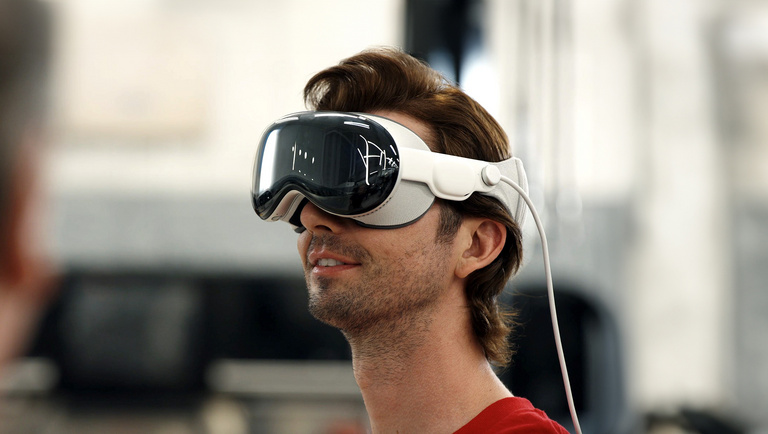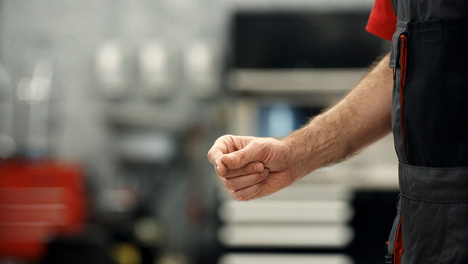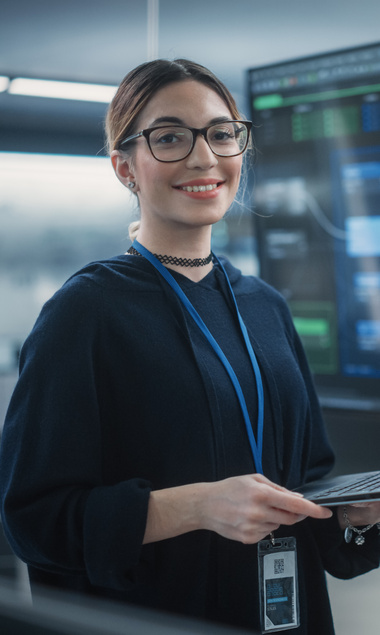
- Blog, Customer Experience & Sales
- Published on: 11.07.2024
- 14:28 mins
Spatial Computing: The Revolution for Production and Training
Improving safety in production, increasing efficiency, and reducing costs at the same time: what seems hard to reconcile becomes possible with spatial computing. This technology allows for the visualization of data models, offering tremendous potential in various areas – from product development and manufacturing to sales and customer service. Spatial computing also presents promising opportunities for employee training and development, such as virtual training sessions. This can help prevent workplace accidents, shorten onboarding times, and conduct training for thousands of employees with an extremely high return on investment. Particularly in light of the growing skills shortage, this opens up entirely new perspectives.
However, decision-makers in companies are often hesitant about adopting digital technologies. This is frequently due to a lack of knowledge and concerns about high investment costs and required efforts.
In this article, you will learn what spatial computing is and how it relates to mixed reality and virtual reality. We will also show you how MHP has taken corporate training at the automotive manufacturer Porsche to a whole new level with a virtual training program developed for Apple Vision Pro as part of a pilot project.
Spatial Computing Explained: Connecting the Physical and Digital Worlds
Spatial computing refers to a technology that seamlessly integrates the physical and digital worlds. Through computers, gadgets, and machines, people can interact with digital objects in real environments, such as a room or physical space.
Connection with Mixed Reality and Virtual Reality
Spatial computing encompasses the concepts of mixed reality and augmented virtual reality. Mixed reality combines physical reality with the digital world, allowing virtual objects to be integrated into and interact with the real environment. Augmented virtual reality takes it a step further: the technology includes both augmented reality (AR) and virtual reality (VR), creating immersive experiences where digital and physical spaces merge.
Natural Interactions Enabled by Spatial Computing
After PCs and mobile devices, spatial computing is seen as the next step in the evolution of computer technology. This technology utilizes advanced sensors, cameras, and algorithms to understand and respond to the environment. As a result, it introduces new forms of interaction that are more intuitive and natural compared to traditional mouse and keyboard controls. With spatial computing, you can place digital information directly into your surroundings, opening up new application areas that extend well beyond traditional screens.
Technology with a Vision: How Spatial Computing Works
Spatial computing harnesses a combination of advanced hardware and intelligent software. These components work together to perceive the real world and seamlessly integrate digital information into it.
Using spatial sensors and cameras, AR apps or Internet-of-Things devices first capture the environment, tracking movements and positions in real-time. Powerful processors then process the captured data, performing complex calculations to accurately place digital objects within the physical environment. In addition to rendering software that generates visual representations, artificial intelligence (AI) plays a crucial role: it analyzes and predicts interactions between users and digital objects, dynamically adjusting the environment accordingly. AI is particularly advantageous for visualizing dashboards and large datasets in 3D, as it excels in extracting and highlighting relevant information.
AR and VR devices, holographic displays, or other wearable devices then project digital content – including home screens and virtual controls – into the users' field of view. Users interact with the spatial computer using methods such as voice commands, gestures, or eye movements. The computer responds to these natural interactions, such as hand gestures, voice commands, and eye movements, ensuring an intuitive user experience.
Examples of Practical Applications of Spatial Computing
By combining these technologies and approaches, spatial computing enables a seamless fusion of digital and real worlds, providing an exceptionally immersive user experience. This, in turn, opens up numerous applications across various fields, such as:
- Entertainment and Media: Spatial computing is revolutionizing the entertainment industry, finding applications in areas such as video games, sports events, concerts, and documentaries. Users can immerse themselves in virtual stadiums, experience NFL, soccer, or motorsport events up close, and feel like they are attending live music events. With AR and VR devices, users dive into realistic and interactive environments that also provide deeper insights during documentaries or TV content. Spatial sound or spatial audio enhances the experience with three-dimensional sound perception, making it even more realistic. Special camera technology is used to enable this immersive experience in spatial computing.
- Urban Planning and Architecture: Spatial computing enables the 3D modeling and visualization of buildings and entire cities in urban planning and architecture. This technology is particularly advantageous for architects and planners because designs and changes are easier to view and understand in VR and AR. Spatial computing helps in the early detection of potential issues and fosters innovative solution development. Additionally, clients of architects and planners can benefit from spatial computing. Examples include project planning like innovative charging centers, kitchen layout designs, or the exploration of high-tech apartments through immersive 3D visualizations, making them more realistic and tangible.
- Product Development and Sales: Spatial computing offers advantages for both businesses and consumers in product development. On one hand, developers can visualize prototypes in photorealistic 3D, making design and testing phases more efficient. On the other hand, consumers can use AR apps, such as the Porsche Car Configurator, to view and customize products in their own environment before making a purchase decision.
- Education and Training: Interactive learning environments through VR and AR are undoubtedly the future of education and training. Students, trainees, and apprentices can learn and practice in realistic simulations, making complex concepts tangible and increasing motivation and learning effectiveness. Especially for younger generations, these learning environments can be enriched with gamification elements to make the content more engaging and appealing. In professional development, new opportunities are also emerging: virtual product presentations for cars, dealer training sessions, and machine training are just a few examples of how spatial computing is revolutionizing the education and training sector.
- Maintenance and Repair: In industrial maintenance, AR devices display instructions and real-time data directly in the technicians' field of view as they work on machines. This significantly improves the efficiency and accuracy of repair and maintenance tasks. Furthermore, maintenance scenarios can be efficiently and cost-effectively tested using spatial computing applications. An additional benefit is that experts can remotely connect to the device to provide direct real-time support.
Benefits and Potential: Profiting from Spatial Computing
Spatial Computing opens up new opportunities for interaction, visualization, and information utilization. The technology not only offers numerous applications but also a host of advantages.
- Optimizing Visualizations: Spatial Computing enables you to visualize complex data and scenarios realistically and in high resolution. Through 3D models and immersive environments, users can perceive objects and processes in detail and with realism. This facilitates understanding and analysis of information that is difficult to portray on traditional 2D screens.
- Increasing Interactivity: Furthermore, thanks to Spatial Computing, users can interact directly with digital objects in their real environment. Through intuitive and natural controls such as gestures, voice, and eye-tracking, interaction with digital content is made user-friendly.
- Realistic Simulation: Through realistic simulations and overlays, users can seamlessly integrate virtual and physical worlds. This is particularly advantageous in areas where realistic and practical scenarios provide added value, such as in education and training. Users can experience and practice situations that would be too expensive or dangerous in the real world.
- Increasing Production Efficiency: Spatial computing enhances production efficiency by providing precise and context-specific information directly at the workplace. AR and VR devices can display step-by-step instructions and real-time data to production workers, reducing error rates and increasing productivity. Moreover, these devices enable continuous and highly precise quality control during the production process, allowing you to streamline processes and optimize resource utilization.
- Enhancing Precision: Complex tasks can be solved more accurately with spatial computing. Technicians and professionals receive detailed visual aids and instructions through AR and VR, enabling them to work with greater precision and safety. This is particularly advantageous in industrial maintenance and construction contexts.
- Enhancing Learning Efficiency: Spatial computing revolutionizes the learning and training experience by creating interactive and immersive learning environments. Students, trainees, and apprentices can practice and learn in virtual worlds, which increases engagement and learning retention. The use of gamification elements makes learning particularly attractive and exciting for younger generations. Additionally, Spatial Computing makes complex subjects understandable and vivid, ultimately improving long-term learning outcomes.
Addressing Challenges of Spatial Computing
Despite its many advantages, few companies have adopted Spatial Computing so far. This reluctance is primarily due to various challenges surrounding the technology.
Acquisition and development costs
One of the biggest challenges associated with Spatial Computing are the acquisition and development costs. High-quality VR and AR devices, sensors, and powerful computers come at a significant expense. Moreover, custom applications and software solutions also require substantial investments.
Lack of IT Expertise
Additionally, spatial computing is susceptible to technical disruptions. These complex systems and devices require continuous updates and maintenance to function smoothly. The lack of IT expertise within the company can deter decision-makers from adopting this technology. Another challenge is establishing a consistent database of 3D objects. This applies to integrating spatial computing into the existing IT infrastructure as well: the systems used must be compatible with the new technologies, necessitating comprehensive adjustments and upgrades to the current IT landscape.
Data Privacy
Data privacy and security concerns pose critical challenges in the implementation of spatial computing. Real-time data capture and processing carry the risk of security breaches, especially when sensitive or personal information is involved. IT security is particularly crucial, as much of this data is streamed from cloud environments. Many companies are uncertain about how to handle these technologies and the associated data privacy requirements due to inadequate expertise in this area.
Motion Sickness
Motion sickness can affect some users when the visual system and the body's balance system are not synchronized, leading to nausea and discomfort. This issue is particularly relevant during extended use of VR devices, whereas it occurs less frequently with AR. The latest generation of devices has significantly reduced latency to almost zero, thereby reducing the occurrence of motion sickness. Experts assist companies in developing ergonomic and user-friendly designs that further mitigate motion sickness.
Lack of Acceptance Among Employees
Another challenge can be the lack of acceptance of the technology among employees. Training initiatives and workshops help impart the necessary knowledge to employees and reduce apprehensions. User-centered design, feedback for optimization, success stories, and case studies further persuade users to adopt spatial computing.
Furthermore, ensure optimal integration of the technology into your existing work culture through adjustments. Incentives for early adopters, transparent communication regarding data privacy and security measures, and pilot projects demonstrating the practical benefits of Spatial Computing can reduce skepticism. Individual adjustments to AR devices, such as optical corrections, can significantly enhance the acceptance of spatial computing as well.
Excellently Implemented: Virtual Training at Porsche
How Spatial Computing can be implemented in practice was demonstrated by MHP at Porsche AG. MHP implemented the technology through the "Shopfloor Training Program", specifically designed to provide cost-effective and interactive employee training for Porsche Production.
Implementation of Spatial Computing in Training Programs
For the automobile manufacturer, spatial computing offers the opportunity to prepare trainees for complex work scenarios. This eliminates the need to shut down production facilities for training purposes, which has historically incurred significant costs. Some companies have even purchased their own robots and machinery solely for training purposes, requiring substantial investments. Spatial computing reduces these expenditures significantly while enabling more efficient training programs to be conducted.
Usage of Mixed Reality Headsets
Porsche AG used the Apple Vision Pro mixed reality headset: This technology enables apprentices to view realistic representations of CAD data for a robot and a rotating table, facilitating learning through practical interaction. Additionally, detailed repair instructions appear, enhancing the efficiency of training sessions. AR technology allows for assessments to measure learning progress. The training program allows apprentices to learn an entire production cycle and perform manufacturing processes alongside robots. In this implemented scenario, gesture control, eye-tracking, and hand-tracking are combined, showcasing the full spectrum of spatial computing capabilities.
Expansion of Application Scope
Thus, "Shopfloor Training" enables a better understanding of machines and their maintenance, offering hands-on training that is practical and shortens the learning curve. It's no surprise that Porsche plans to implement the Apple Vision Pro and applications like "Shopfloor Training" in general production in the long term, to continuously train and educate employees.
Furthermore, the company envisions significant potential in utilizing this technology for customer service in the future. Employees, for instance, can use the Apple Vision Pro to experience realistic simulations, enabling them to perform better, more accurate, and faster repairs. This results in improved service quality and reduced errors. The device provides detailed instructions that are accessible even without extensive prior knowledge.
Modernizing and Optimizing Work Processes with MHP
MHP has clearly succeeded in developing a cost-effective and interactive training method with "Shopfloor Training". This application can be expanded in the future to include additional training scenarios from various work areas and features an intuitively accessible user interface. Moreover, this application is of interest to other companies as well: "Shopfloor Training" demonstrates how spatial computing can revolutionize industrial training and contribute to the education of future skilled professionals and leaders.
MHP is at the forefront of this revolution: together with the IT company TRIFORK, we are designing tailored employee training programs for manufacturing companies. MHP is among the first companies in Europe to develop applications for the Apple Vision Pro. Our focus is on realistic, location-independent training experiences, a wide variety of applications and content, and intuitive user interfaces.
However, MHP not only focuses on innovative solutions in employee training. We also offer applications in product development and configuration. Our technology allows for the display and sharing of 3D models in photo-realistic detail. This allows customers to configure their vehicles conveniently from home or in a showroom using a car configurator, providing them with an immersive experience.
Benefit from our expertise in Spatial Computing
Take full advantage of spatial computing: as your service and consulting partner for IT and innovative digital technologies, we assist companies and manufacturing plants in optimizing their processes. This includes areas such as employee training, product development, quality assurance, maintenance, and service. We offer tailored immersive products that enable you to increase your efficiency and quality. Essentially, all visualizations can be supported and enhanced with this new technology. Contact us to learn more about your individual possibilities.
Conclusion: Make Spatial Computing a Reality
Augmented reality and virtual reality are no longer just visions of the future. In today's world, spatial computing gadgets enable humanity to create a new, combined reality from physical spaces and digital objects. Spatial computing opens up particularly unique opportunities across various fields, whether in education and training, product development, or customer interaction. With this technology, companies can conduct cost-effective training sessions, make learning engaging and educational through interaction and gamification, and offer innovative product configurations and realistic simulations for customers. Moreover, over time and with increasing experience, it becomes evident in which other areas this technology can be utilized, highlighting the enormous potential and versatility of spatial computing.
So that your company can fully leverage these advantages, MHP offers comprehensive consulting and expertise, developing and implementing suitable applications. Innovative solutions such as "Shopfloor Training" demonstrate that efficiency improvement, cost reduction, and safety optimization can be seamlessly integrated – representing a promising opportunity for businesses.
Important Questions and Answers about Spatial Computing
Spatial computing expands upon traditional virtual reality (VR) by merging physical and digital worlds. While VR generates entirely virtual environments, spatial computing integrates real and digital elements. Additionally, spatial computing utilizes advanced sensors and algorithms to perceive the environment, allowing humans to interact with digital objects through gestures, voice commands, and gaze control.
Spatial computing enhances productivity and efficiency in production by providing real-time information and instructions instantly. This capability helps to reduce errors and enables precise, fast, and reliable completion of complex tasks. Moreover, the need for physical prototypes and training sessions is reduced, resulting in time and cost savings.
One of the most significant challenges for many companies considering spatial computing is likely the cost. Both hardware and software can be relatively expensive to acquire. Additionally, there is a high maintenance burden, uncertainties regarding data privacy and security, and the need to integrate the technology into existing IT infrastructure seamlessly. However, despite these challenges, the investment is worthwhile as Spatial Computing can lead to significant long-term efficiency gains, innovative training methods, and improvements in product quality. Companies that adopt this technology early on can gain a decisive competitive advantage and strengthen their market position sustainably.
MHP utilizes Spatial Computing to develop innovative and versatile solutions across various business sectors. This includes virtual training with lifelike learning environments that enable cost-effective and engaging education and development, focusing on gamification and interactivity. Additionally, we create immersive product configurations, realistic simulations, and interactive customer interactions. We leverage technologies such as Apple Vision Pro to ensure utmost user-friendliness and usability independent of location.






